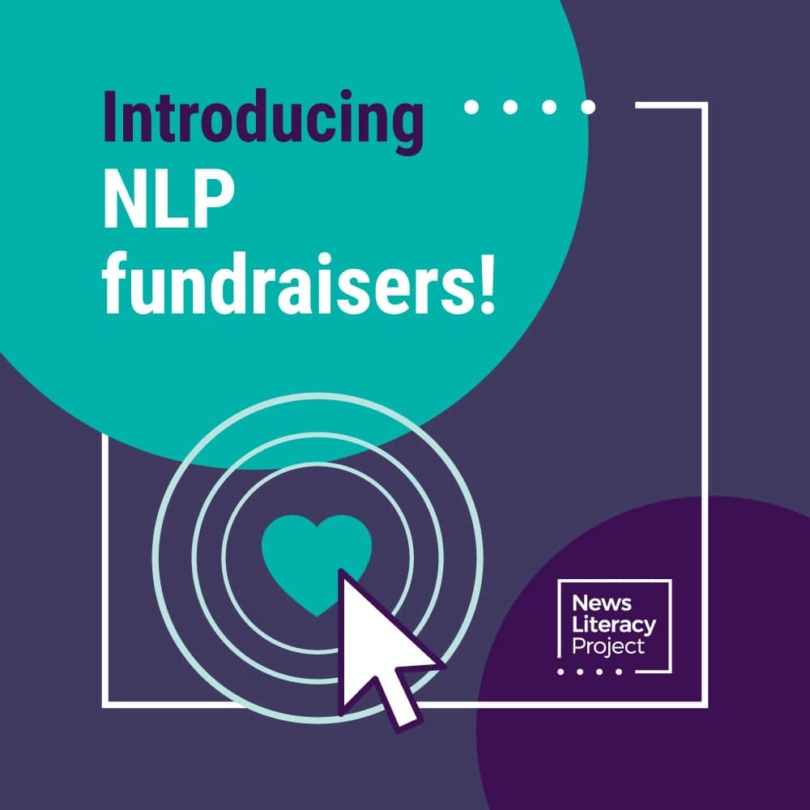In CNN piece, NLP urges care and transparency as journalism embraces AI
Peter Adams, the News Literacy Project’s Senior Vice President of Research and Design, was featured in a CNN article examining the use of artificial intelligence to generate content in newsrooms and the challenges it raises around verification and transparency. “It is precisely because AI is prone to errors that newsrooms must maintain the ‘fundamental standards and values that have long guided their work,’” Adams told CNN.
Read the story here.
How AI Shapes What We See (And What We Miss)
From shaping our social media feeds to influencing the news we see, algorithms and artificial intelligence are transforming the way we consume information. But how do these technologies work, and what impact do they have on our ability to distinguish fact from fiction?
To get to the bottom of these questions, the News Literacy Project hosted a conversation with reporter Mia Sato, who covers the tech world and AI’s influence for The Verge. Attendees left equipped with strategies to help students develop a more critical approach to digital news consumption. Preview Sato’s takeaways about AI and algorithms below, and view the webinar in full on edWeb.

“AI tools allow users to flood the zone with more content – not necessarily better content.”
👀 Have a critical eye
Synthetic content is everywhere. AI-generated images permeate social media feeds, search engines use AI to synthesize short answers to users’ questions, and news sites may include AI-generated “takeaways” at the top of stories.
To spot synthetic content as you scroll, Sato recommends paying attention to the details. When examining images, zoom in and analyze any images of people, as most AI technologies still struggle to depict human anatomy with complete accuracy. Clothing or hair that disappears into a body? Mangled hands or extra fingers? There’s your sign it might be AI-generated. You can similarly spot AI-generated audio by focusing on the details. Does the voice have an unnatural, robotic cadence? Check the source of the content and confirm with other credible sources — it might be AI-generated.
Clues may be hard to find in visuals or audio. So, don’t neglect to consider factors like:
- Are other news outlets covering the “story”?
- Who is elevating and spreading the story? Is their motive to inform or to profit?
- What are other users saying?
“Tech companies optimize for engagement, time spent, and growth – not necessarily what users want, what’s more accurate, or what’s ‘right.’”
⚙️ Remember the algorithm
In addition to generating images, text, or audio, AI and machine learning also influence the systems that put that synthetic content in front of our eyes. Algorithms are complex webs of instructions and computations that affect everything from the order that links appear in when we conduct a Google search to the restaurants that populate when we open food delivery apps.
These days, social media is not limited to posts from people we choose to follow. It is an abyss of content from creators around the globe, all of which algorithms may choose to put on our feeds.
Algorithms focus on showing us content we are likely to be interested in and likely to engage with. Sato reminds us: Do not rely on social media platforms to show you diverse content or a range of perspectives. Online experiences are highly personalized.
“Algorithms can be very opaque. That’s why they’re sometimes called a ‘black box,’ because nobody can really see into it, even the developers who created the algorithms.”
🪞 Reality check
Our social media feeds and internet search results are closely aligned with our lives and interests. The internet no longer polarizes people, Sato said; it fragments them into small silos of reality.
“It’s easy to lose sight of what everyone else is looking at,” Sato said, but it is important to remember that everyone’s digital experience looks different, and the stream of content fed to one individual is not necessarily representative of reality on a broad scale.
“Platforms are not just pushing people apart, but they’re making small, siloed bubbles of reality.”

Teaching about AI is easier than you think
Looking for an easy point of entry for students to start thinking about AI and responsible online habits? NLP’s “Introduction to Algorithms” lesson on the Checkology® virtual classroom introduces students to algorithms, search engines and AI tools while prompting them to weigh the civic and social impact of these technologies. And, it’s free!
Need an option for younger students? Try “For Elementary: Search and Suggest Algorithms.”
Cracking the Code: How AI Shapes What We See (And What We Miss)
This free webinar for educators, presented by the News Literacy Project on edWeb.net, will offer strategies for teaching students about algorithms and artificial intelligence.
Cracking the Code: How AI Shapes What We See (And What We Miss)
Wednesday, April 9, 2025
5 p.m. ET/2 p.m. PT
From shaping our social media feeds to influencing the news we see, algorithms and artificial intelligence are transforming the way we consume information. But how do these technologies work, and what impact do they have on our ability to distinguish fact from fiction?
Join the News Literacy Project for an in-depth conversation about the evolving role of AI and algorithms in news and social media.
You’ll learn directly from reporter Mia Sato, who covers the tech world and AI’s influence for The Verge.
Together, we’ll explore the rise of AI-generated content, machine learning systems that use data to shape our information bubbles, and the challenges posed by deepfakes. We’ll equip you with strategies to help students develop a more critical approach to digital news consumption.
By the end of the session, you’ll be armed with information about the ongoing evolution of AI, a deeper understanding of how we shape—and are shaped by—algorithms, and a toolbox of resources to support you in teaching your students. We will highlight Checkology®, our free, interactive e-learning platform designed to help educators provide essential news literacy skills to students.
This edWebinar will be of interest to middle and high school teachers, librarians, school leaders, district leaders, and education technology leaders. This event complements NLP’s “Spring Sprints” resources.
🎁 All attendees will be automatically entered into a drawing to win a care package of NLP goodies.
Don’t miss this unique opportunity – reserve your spot today!
(Can’t make it at this time but still interested? Register anyway, and we’ll email you the recording.)
For the Washington Post, Peter Adams helps news consumers identify AI-generated images
With advancements in artificial intelligence, news literacy skills are key to recognizing when photos are faked or altered. The Washington Post recently published a guide for identifying doctored images and included NLP’s expertise.
Peter Adams, Senior Vice President of Research and Design at NLP, advises in the story to look out for images that are circulated out of context, which changes their meaning. These images can be hard to spot because they appeal to “intuitive, gut thinking,” Adams says.
Read the full story here.
For more resources about finding credible information in the age of AI, browse our free resource page.
NLP’s Veiga on CNN: How to detect AI-generated news stories
In a CNN interview, the News Literacy Project offered strategies for determining whether news coverage is AI-generated.
Christina Veiga, NLP’s senior director of media relations, explained how to read laterally – leaving one online source to read what others have to say about a topic or issue – and how to conduct a reverse image search to investigate whether humans or AI are behind the news you consume.
Watch the full report here.
Bloomberg, CNN quote NLP experts on AI-generated news
A San Francisco-based news outlet with coverage spanning several major cities across the country is publishing AI-generated articles attributed to non-existent authors. News literacy experts warn that this use of artificial intelligence could lead to declining trust in news organizations.
“In trying to use a human-sounding name, they’re trying to game the system and taking advantage of people’s trust,” Hannah Covington, NLP’s senior director of education content, said in a recent Bloomberg article
“It’s a kind of flagrantly opaque way to dupe people into thinking that they’re reading actual reporting by an actual journalist who has a concern for being fair, for being accurate, for being transparent,” Peter Adams, NLP’s Senior Vice President of research and design, told CNN.
Read the full Bloomberg article here and the full CNN article here.
